The Best Mobile Air Compressors For Municipalities
There are three primary mobile air options on the market today: tow-behind, vehicle-mounted, and vehicle integrated. Each option has its advantages and disadvantages.
Tow-Behind Air Compressors
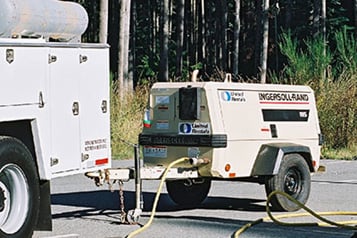 Many municipalities have used tow-behind air compressors for decades because they are easy to source, can be moved to various work sites, and can produce high volumes of air. While these are notable benefits, other mobile air solutions can achieve them, too.
Many municipalities have used tow-behind air compressors for decades because they are easy to source, can be moved to various work sites, and can produce high volumes of air. While these are notable benefits, other mobile air solutions can achieve them, too.
However, tow-behind air compressors have significant disadvantages. Tow-behind air compressors are bulky, heavy, and take up a lot of space. They leave no room for other towed equipment, so workers must make multiple trips or transport multiple vehicles to a single site. It’s also a hassle to hitch the compressor onto a vehicle and carefully plan where to bring it for each use.
Tow-behind air compressors also have expenses beyond the initial purchase, as these compressors require additional insurance, engine maintenance, and repair. These costs add up, making tow-behind air compressors deceptively more expensive than their price tag suggests.
For an additional analysis of the downside of tow-behind air compressors, check out 9 Reasons To Ditch Your Tow-Behind Air Compressor. Given all the unnecessary drawbacks, tow-behind air compressors often aren’t the optimal mobile air solution.
Vehicle Mounted Air Compressors For Municipal Work
A better air compressor solution for municipal work is vehicle mounted air compressors. As the name implies, these air compressors mount directly to the vehicle, and refer to both abovedeck and underdeck solutions.
Size and weight are important considerations for vehicle mounted air compressors, so choosing the smallest and lightest air compressor that will meet your CFM requirements is best. Doing so will help reduce GVW, minimize fuel consumption, increase available cargo space, and reduce associated tow-behind expenses.
Municipal workers who need air power should also consider rotary screw air compressors over reciprocating compressors. Rotary screw air compressors operate at 100% duty cycle and do not require an air receiver tank to store air, making them a more efficient solution. In addition, rotary screw air compressors also tend to be smaller and lighter than reciprocating air compressors, resulting in a more compact and powerful mobile air solution.
Abovedeck Vehicle Mounted Air Compressors
Abovedeck vehicle mounted air compressors are bolted onto a vehicle’s side pack or deck area and are available with gas or diesel engines or as a hydraulic driven option. As a rule, try to choose a vehicle mounted air compressor that matches the vehicle’s fuel type to simplify the fueling process.
Gas Driven Air Compressors
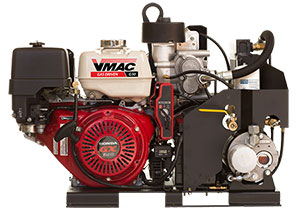 Gas driven air compressors are a popular type of air compressor because they are simple to operate, easy to source, and budget-friendly. They are a smart solution for budget-oriented fleets and are suitable for small to medium-sized air tools, including ¾” impact wrenches, 2” grinders, and chipping hammers.
Gas driven air compressors are a popular type of air compressor because they are simple to operate, easy to source, and budget-friendly. They are a smart solution for budget-oriented fleets and are suitable for small to medium-sized air tools, including ¾” impact wrenches, 2” grinders, and chipping hammers.
VMAC manufactures an affordable 30 CFM gas driven air compressor called the G30, which is used in municipalities across North America. At 58% lighter than competing products, the G30 is remarkably light, small, and powerful compared to alternative options.
Diesel Driven Air Compressors
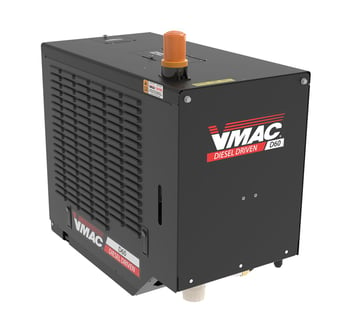 Diesel driven air compressors are also a popular mobile air solution for municipalities across North America. They are a great fit for people who work with diesel trucks, and some diesel driven air compressors can plumb directly into the truck’s fuel supply, making it an even more convenient solution.
Diesel driven air compressors are also a popular mobile air solution for municipalities across North America. They are a great fit for people who work with diesel trucks, and some diesel driven air compressors can plumb directly into the truck’s fuel supply, making it an even more convenient solution.
The ideal diesel driven air compressors are powerful, lightweight and small. For example, VMAC’s D60 diesel driven air compressor produces 60 CFM, which can power 1” impact wrenches and 60 lb jackhammers. Yet, the D60 only weighs 425 pounds, compared to 735 pounds for competing products. This significant size and weight savings allow municipal workers to do more with their trucks while still benefiting from constant access to on-demand compressed air.
Hydraulic Driven Air Compressors
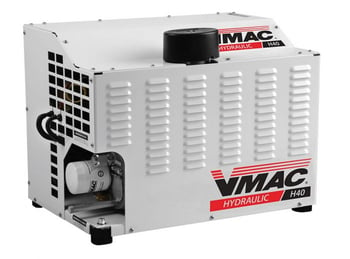 Hydraulic driven air compressors are another fantastic option for municipal fleets with crane trucks.
Hydraulic driven air compressors are another fantastic option for municipal fleets with crane trucks.
Hydraulic air compressors use the vehicle’s engine to turn the transmission, which turns the PTO, which turns a hydraulic pump that pumps hydraulic fluid to power the air compressor. Because hydraulic air compressors connect to a vehicle’s existing hydraulic system and are a sleek, streamlined solution without additional fuel costs.
VMAC hydraulic driven air compressors can produce between 25 to 60 CFM, which gives them enough air to power small to medium-sized tools. At 58% smaller and 23% lighter weight than competitive products, they are specifically designed and engineered to be compact for service trucks and applications where space is limited.
Vehicle-Integrated Air Compressors For City Work
Vehicle-integrated air compressors are mobile air compressor solutions that use a truck’s existing power sources to power the system. As a result, these air compressors are innovative, powerful, and don’t take up any deck or cargo space.
Vehicle-integrated compressors are an excellent option for city work because they are convenient, require minimal maintenance, and handle most municipalities’ full range of needs. These compressors can also provide high CFM outputs, making them an excellent solution for work that requires medium to larger-sized tools.
The two types of vehicle-integrated mobile air compressors are UNDERHOOD® and underdeck.
UNDERHOOD® Air Compressors
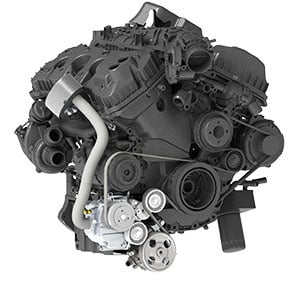 VMAC works closely with Ford, GM, Ram and other OEMs to design air compressors that are integrated into the vehicle engine compartment. UNDERHOOD air compressors are mounted within the engine compartment of a service vehicle, using the vehicle’s engine as a power source. VMAC exclusively manufactures UNDERHOOD systems, as no other manufacturer has developed an air compressor that’s small enough to fit within various engine compartments.
VMAC works closely with Ford, GM, Ram and other OEMs to design air compressors that are integrated into the vehicle engine compartment. UNDERHOOD air compressors are mounted within the engine compartment of a service vehicle, using the vehicle’s engine as a power source. VMAC exclusively manufactures UNDERHOOD systems, as no other manufacturer has developed an air compressor that’s small enough to fit within various engine compartments.
UNDERHOOD70s and 150s don’t take up a single inch of deck space and provide air-on-demand anywhere the truck goes. Workers never have to think about whether they will need compressed air because it will always be available to them. UNDERHOOD air compressors are a popular choice for municipalities because of their convenience.
“We had two very old trailer-mounted air compressors that needed to be replaced and were shared between departments, and they always needed some type of repair when they needed to be used. This wasn’t convenient when an unanticipated need for compressed air on a job site came up,” said Buzz Kirby, Fleet Supervisor for the City of Livonia’s Department of Public Works.
“Now that the UNDERHOOD air compressor is with the truck, it is ready to use whenever there is a need for compressed air on the job site. There’s no lost time traveling back to the yard to get a compressor, and we don’t have to tow a trailer.”
UNDERHOOD air compressors are engineered for specific truck model years, ensuring compatible and efficient solutions. At present, these revolutionary air compressors are available for common Ford, RAM, and GM/Chevy service trucks.

Underdeck Air Compressors
Underdeck air compressors are air compressor systems mounted underneath the deck of a vehicle. This placement keeps them out of sight and out of mind, providing the space and weight benefits of a vehicle-integrated system.
There are three primary types of underdeck air compressors: hydraulic-driven, shaft-driven and transmission-mounted.
Shaft Driven Underdeck Air Compressors
Shaft driven air compressors mount the air compressor where there is the most space under the vehicle, using a shaft to connect to the transmission via PTO. With many underdeck kits, customers are required to supply or custom-order this shaft. Underdeck air compressors also require modifications to the vehicle transfer case, can lower the clearance of a vehicle, and aren’t the best solution available.
Hydraulic Underdeck Air Compressors
Hydraulic underdeck air compressors connect to a vehicle’s existing hydraulic system, similar in concept to the abovedeck hydraulic air compressors, but typically provide 80+ CFM of air. These air compressors are for applications that don’t have the space for traditional shaft underdeck air compressors, either due to size limitations or because the space is already used for a large hydraulic pump to run lift axles, large cranes, and so forth.
Hydraulic air compressors require a sizeable hydraulic system and other hydraulic functions to run. For this reason, they aren’t suitable for many mobile applications and tend to be used with custom OEM applications instead.
Direct-Transmission Mounted Air Compressors
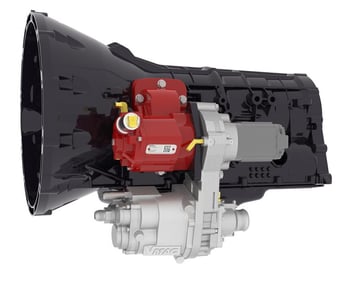 A superior underdeck solution is transmission-mounted air compressors, which connect directly to a PTO port on the vehicle’s transmission. These air compressors are incredibly compact, providing significant compressed air power from the smallest unit possible.
A superior underdeck solution is transmission-mounted air compressors, which connect directly to a PTO port on the vehicle’s transmission. These air compressors are incredibly compact, providing significant compressed air power from the smallest unit possible.
At the time of writing, VMAC manufactures the world’s only transmission mounted air compressor. VMAC’s Direct-Transmission Mounted (DTM70) air compressor produces 70 CFM, which is enough to power 1” impact wrenches, 60 lb jackhammers, and many other tools. The DTM70 is frequently used in utility servicing, sign installation, and heavy equipment repair.
VMAC also has a direct-transmission mounted air compressor with hydraulics called the DTM70-H. This multi-power system allows operators to use compressed air and hydraulics simultaneously.
Like UNDERHOOD air compressors, the DTM70 systems are engineered for specific vehicle model years and are available for most modern Ford and RAM work trucks. Call VMAC at 1-888-514-6656 or check out VMAC’s application list for more information.
